My Town: Danbury
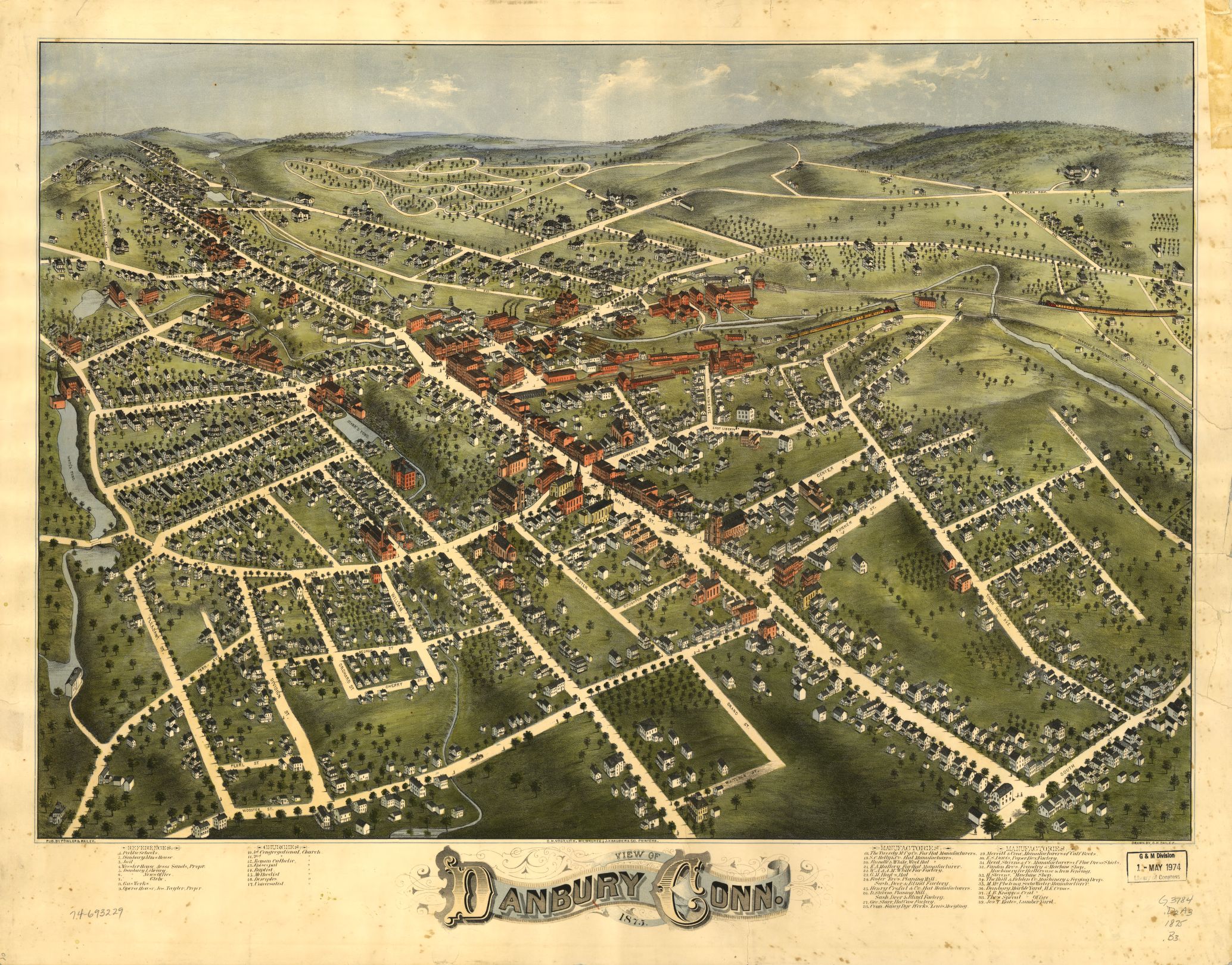
View of Danbury, 1875. Library of Congress
Where is my town?
Danbury is in the southwestern part of Connecticut. Its western border is the state border. It is on the border of New York. Candlewood Lake forms part of the northern border. The lake is the largest man-made lake in Connecticut. The Still River runs through Danbury.
How was it founded?
The Pahquioques lived in the area. They called the area Pahquioque which means open plain.
In 1684, the Connecticut General Court approved a new town. The land was purchased from the Pahquioques. Eight families from Norwalk and Fairfield settled near the Still River. The settlers wanted to call the town Swampfield. Governor Robert Treat decided to call the town Danbury. It is named after a city in England.
How do its residents make a living?
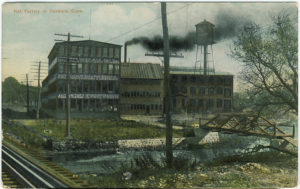
Postcard of a Danbury hat factory, 1911
The land along the Still River was good for farming. Dams were built to power mills. The mills ground grain. Beans were a popular crop. Some people called Danbury “Beantown.”
It is said that Zadoc Benedict opened the first hat shop in Danbury in 1780. Making hats required a lot of water. The Still River provided that water. The river also took the waste from hat making away.
The hatting industry became one of Danbury’s largest industries. Factories made fur felt to make into hats. Factories made hatboxes, silk lining, hatbands, and ribbons. Other factories made the tools and machines needed to make hats.
The railroad came to Danbury in 1852. A good transportation system helped the hat industry grow. “Danbury Crowns Them All” became the motto of the town.
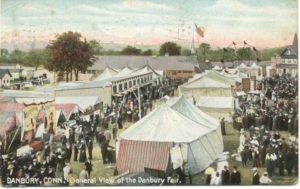
Postcard of the Danbury Fair, 1908
Farming was still important, too. The first Danbury Fair began in 1869. Local farm families showed off their crops, farm animals, and things they made. The Danbury Fair became one of the largest in the state. School was closed for the day so that everyone could go to the fair.
Hats began to go out of style in the 1950s. Hat factories began to close. The last hat factory in Danbury closed in 1987.
Today, Danbury businesses and industries make many things. They make medical and pharmaceutical products, electronic equipment, plastics, and machinery. The mirrors for the Hubbell Space Telescope were made in Danbury.
The Danbury Fair closed in 1981. Danbury Fair Mall was built on the fairgrounds. It is the second largest shopping mall in Connecticut. Western Connecticut State University and Naugatuck Valley Community College are located in Danbury.
How did it grow?
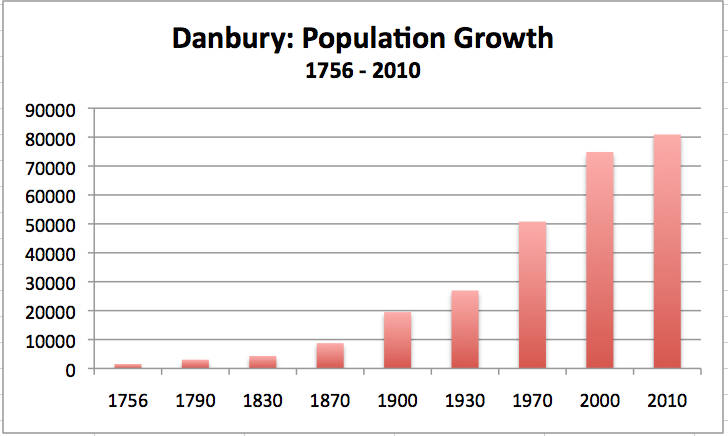 Danbury was a supply depot for the Continental Army during the Revolutionary War. Blacksmiths, coopers, shoemakers, and other craftsmen made things the army needed. Danbury had a military hospital, too.
Danbury was a supply depot for the Continental Army during the Revolutionary War. Blacksmiths, coopers, shoemakers, and other craftsmen made things the army needed. Danbury had a military hospital, too.
The British Army raided Danbury on April 26, 1777. The British destroyed the supplies. Thousands of barrels of meat and flour, and bushels of grain were destroyed. Thousands of pairs of shoes, and 1,600 tents were destroyed, too. Nineteen houses were burned.
The seal of the City of Danbury has a phoenix and two mottoes. The mottoes are: “We Have Restored” and “Let Us Go Forward.”
After the war, industry developed. Danbury was in a good location between New York City and Hartford. Immigrants came to work in the factories. Danbury became a city in 1889.
Two hurricanes hit Connecticut in August 1955. The Still River flooded its banks. Another storm hit in October. The river flooded again. All of the bridges were destroyed. The two floods damaged much of downtown. Many roads, businesses, and homes were destroyed, too.
It no longer seemed like a good idea to have the downtown so close to the river. Instead of moving the town, the river was moved. It was lowered 40 feet. The Army Corps of Engineers put the river in a concrete channel. The Still River Alliance has helped build parks and paths to enjoy the river again.
Today nearly 85,000 people live in Danbury. Its citizens come from all continents and many countries. Students in Danbury’s schools speak more than 50 languages.
Who are its notable people?
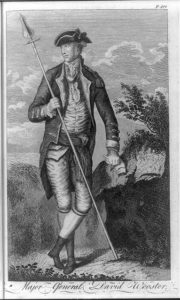
General David Wooster. Library of Congress
David Wooster was a General in the Continental Army during the Revolutionary War. He and his troops were too late to defend Danbury when the British attacked on April 26, 1777. But the next day he led his troops against the British as they returned to their ship. He was wounded and died five days later. He is buried in Wooster Cemetery.
Composer Charles Ives was born in Danbury in 1874. He won a Pulitzer Prize in 1947 for his Third Symphony. He is considered by many to be “The Father of Modern American Music.”
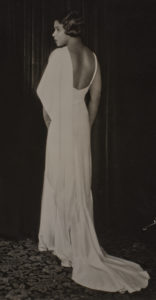
Marian Anderson. The Amistad Center for Art & Culture
Marian Anderson was a famous singer. She sang all over the world. She fought for civil rights. She was awarded the Presidential Medal of Freedom in 1965. She lived in Danbury with her husband for more than 50 years. You can learn more about her story and visit her music studio at the Danbury Museum & Historical Society.
Places to Visit
The Danbury Museum & Historical Society
43 Main Street, Danbury
This story was written with the assistance of the Danbury Museum & Historical Society.





 Danbury was a supply depot for the Continental Army during the Revolutionary War. Blacksmiths, coopers, shoemakers, and other craftsmen made things the army needed. Danbury had a military hospital, too.
Danbury was a supply depot for the Continental Army during the Revolutionary War. Blacksmiths, coopers, shoemakers, and other craftsmen made things the army needed. Danbury had a military hospital, too.
